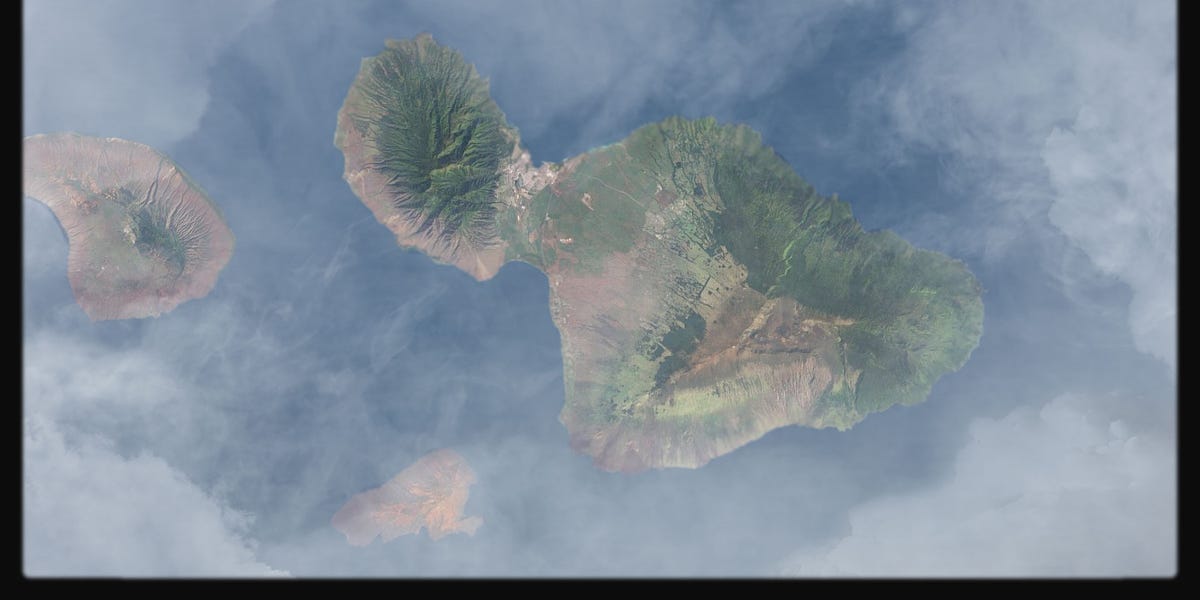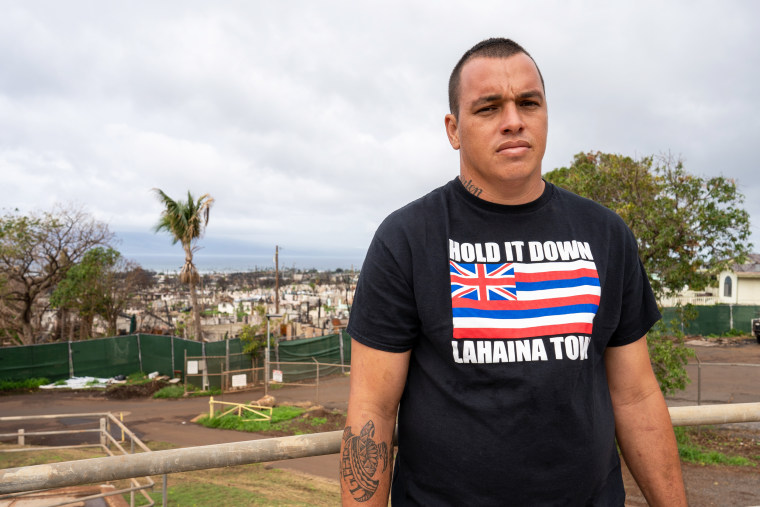Feb. 5, 2024, 11:41 PM CET
By
Alicia Victoria Lozano, Lewis Kamb and
Jon Schuppe
LAHAINA, Hawaii — A shrill smoke alarm startled Manny Ceralde awake from an afternoon nap in his West Maui home.
Manny looked out the window and saw part of his neighbor’s roof break off and disappear into the swirling blackness swallowing the sky.
He screamed to run to the truck, prompting his daughter, 14; his sister, 50; and his mother, 75, to scramble out the front door. But the shouting meant little to Manny’s autistic son, 19, who wandered back into his bedroom.
As Manny guided his son outside, he sensed he had only moments to get his family out of their neighborhood alive.
Kuhua Camp — once temporary housing for sugar cane workers — had grown over more than a century into a cramped subdivision of low-slung homes in the foothills just east of historic Lahaina Town.
Over the years, as dwellings were expanded, sometimes illegally, to accommodate more people, Kuhua Camp’s tangle of already tight streets became even more crowded with cars, trucks and boats — obstacles that made getting into and out of the neighborhood challenging on a typical day.
On that Aug. 8 afternoon, as the wind-driven inferno raged down the mountainside toward town, the neighborhood became a fiery death trap.
“This was the apocalypse and we were ground zero,” said Pam Kim, a longtime resident who fled with four generations of family members. "It was like a warzone."

Six months after one of the deadliest wildfires in modern U.S. history, there still has been no official accounting of where and how its 100 victims died. Maui County has not released any police or autopsy reports in response to public records requests.
NBC News interviewed dozens of residents and experts and analyzed other available information — property records, a database of registered voters, news reports and social media posts — to determine where victims lived at the time of the fire. That review found that at least 43 of the 100 victims on the official list of Lahaina’s dead lived in Kuhua Camp — more than in any other neighborhood.
In response to the findings, Maui County Police Department spokesperson Alana Pico confirmed “the largest concentration of victims are in that area.”
Officers evacuated some nearby neighborhoods to the east and south, and parts of three streets in Kuhua Camp, before the “rapid growth of the fire” forced them to deal with traffic jams caused by masses of fleeing residents, Pico said.
The Maui County mayor’s office and emergency management and fire officials declined to answer NBC News’ questions about the neighborhood’s long-running congestion and access problems. A county spokesperson also declined to comment, citing “numerous lawsuits that involved the subjects you are inquiring about.”
Manny, whose wife was at work when the fire started, got his son into his pickup truck with the other family members. They faced navigational challenges almost immediately. And a dilemma.
To his right, a giant, wind-toppled mango tree blocked narrow Aki Street, cutting off the only route to the rental studio less than three blocks away where his mother-in-law and sister-in-law lived on Mela Street. “If we are able to make it past the fallen tree,” he thought, “we might be trapped” by debris or traffic.
His 81-year-old mother-in-law didn’t have a car, and his wife’s sister needed a cane to walk. He worried that they wouldn’t be able to make it out of the burning neighborhood on their own.
But he also had his family already packed in the truck to worry about. He feared they’d be overcome by smoke if they opened the door. He couldn’t see the flames, but could feel the fire’s blistering heat against his face.
To his left, Aki Street stretched into the smoky darkness and offered one of the few routes out of the neighborhood.
Manny pressed the gas pedal, turned his steering wheel and prayed.
To understand what caused Kuhua Camp to account for so many of the fire’s casualties, NBC News spoke to more than 30 current and former residents, their family members and lawyers, and local authorities and historians. What emerged was a story of a chronically congested neighborhood with rampant access problems that some residents long feared would result in disastrous consequences.
Initially known as “Mill Camp,” the neighborhood’s first homes were built in the 1920s as temporary housing for workers for the Pioneer Mill Co., a sugar cane plantation. The small, wood-frame homes were stacked along a narrow maze of roads that trace their origins to the footpaths worn by sugar plantation workers — decades before the first zoning laws in the 1960s. Some of its paved streets allow for two-way traffic, but others are so narrow that only one car can pass at a time.
The homes were an affordable option for local families once tourism became the island’s economic mainstay and Maui’s housing prices soared. New houses sprouted on small vacant lots, and rogue additions allowed generations of families to share one roof or create a source of income from rental units.
“When you got all these monster homes with these illegal additions, we had tons of cars clogging everything up,” said Kim, a resident since the 1970s. “I’d always comment, `Heaven forbid if somebody is dying up here,’” because a fire truck couldn’t get through.
Occasionally over the past seven years, Kim phoned Maui County to complain about the access problems, but she said officials mostly blew her off. Her husband’s complaints about illegally parked cars on Kuhua Street sometimes prompted police to stop by to ticket the offending vehicles, which would disappear briefly, only to return, she said.
Travis Tancayo, a former Maui County fire battalion chief whose district included Kuhua Camp, said fire crews also knew for years about the access problems.
Firefighters typically responded to medical calls in the neighborhood with a smaller utility truck because driving a fire engine in was too difficult, he said. Kuhua Camp also housed many older residents, including some without vehicles that could get them to safety in an emergency, he said.
“All of these bad factors were stacked up against that neighborhood,” said Tancayo, who worked for the fire department for about 25 years and now serves on the county police commission. “And on that day, they paid dearly for it.”
As the fire spread through Kuhua Camp, the neighborhood’s tight streets, fenced-off access roads, speed bumps and abrupt dead ends made it a life-and-death labyrinth for panicking residents. Hurricane-force winds and flames toppled trees and created even more obstacles. With streets blocked, some people abandoned their cars and ran for their lives. Others burned in their cars.
A woman called 911 from a car near Aki Street, sobbing. A dispatcher told her: “Get out of your car and run.”
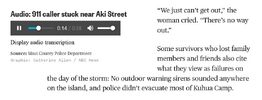
With cell service and power out, many people were left in the dark — in the path of an inferno. “All you see is the smoke blowing down the mountain valley and then boom,” said Anthony Steele, who owns three properties in the neighborhood.
That afternoon, Steele raced from his girlfriend’s condo to his Hauola Place home and found his grandmother sitting at their kitchen table eating lunch, oblivious to the approaching fire.
At first, he said, she didn’t believe there was an emergency because she did not hear a siren or receive an evacuation order.
“With all the money coming in from tourism, they couldn’t even make an exit strategy,” Steele said.

Pico, the police spokesperson, said officers tried to evacuate homes farther uphill off Lahainaluna Road, going door to door along two streets. Later, as the fire grew and spread downhill toward Kuhua Camp, officers drove several streets nearby, ordering evacuations from their cars, she said. Those drive-by evacuations included two streets and a cul-de-sac in Kuhua Camp.
With the fire’s “rapid growth,” officers shifted their attention “to areas outside of the neighborhood” to help ease traffic jams, Pico said.
She confirmed that officers didn’t evacuate Hauola Place, where Steele lived.
Steele said he tried to warn his tenants to evacuate as the fire approached, running door to door with a wet T-shirt wrapped around his head. Only one stayed behind, he said, to try to fight the fire. His charred remains were identified weeks later.
Anthony Steele raced to his home in Kuhua Camp to help evacuate his grandmother. David Douglas / NBC News
Born in the Philippines, Manny, 52, and Claire, 47, had lived in the hillside village of Kuhua Camp for 20 years with their extended family.
The Ceraldes, who spoke to NBC News in a series of interviews in English and in their native Tagalog through a translator, said they had started permitted renovations on their house on Aki Street in 2022 to add two apartments. One was intended to be a rental property, and the other was for Claire’s mother, Revelina Tomboc, and her sister, Bibiana “Bhing” Lutriana, 58, who both had lived with the family for more than a decade.
Manny said he and Claire were thrilled when an affordable rental opened up less than three blocks away. That way, Tomboc could live comfortably during the construction and still visit her grandchildren every day and watch Korean soap operas with Claire.
That Tuesday morning in August, Manny and Claire didn’t worry as winds whipped the neighborhood and knocked the power out. They’d weathered heavy storms before. Claire crept out of the house around 6 a.m., careful not to wake her family, before driving 10 minutes north to a Ka’anapali hotel, where she worked as a cashier.
Around noon, Manny stepped out of Safeway market after finishing his shift as a wine merchandiser. He saw dark plumes gathering above his neighborhood off Lahainaluna Road, a main thoroughfare.
He assumed the fire was under control as he drove home to rest before leaving for his second job. Manny heard sirens in the distance but did not see any fire trucks. “I had peace of mind. I trusted them,” he said later of the firefighters.
Still, Manny packed cash savings and rare coin collectibles into a backpack and set it next to him in case of an evacuation. He lay down on his living room couch around 2:30 p.m.
About the same time, a few blocks away, Vanessa Keau pulled up to a home on Mela Street to check on her 83-year-old mother, Gwendolyn Kanani Puou. Keau went inside her mom’s house, but no one was there. She went downstairs and knocked on the door to the studio apartment rented to Manny’s in-laws — Tomboc and Lutriana. No one answered.
Keau’s mother didn’t have a car — and neither did her tenants. Before Keau drove away, she prayed that her mother, who had diabetes and a weak heart, was somewhere safe.
Around 3 p.m., Manny bolted out the door of his house with his son, piling into the truck with the rest of his family. He forgot his bag of cash and collectibles.
After seeing the big mango tree blocking Aki Street to the right, Manny took a left to escape — the opposite direction of his in-laws’ home.
He drove over scattered tree limbs and debris before passing an old woman he didn’t recognize outside her house. She held a hose with water barely dripping from its nozzle. He noticed the bottom of her dress starting to catch fire.
He thought of trying to squeeze her in the already packed truck. But Manny’s mother cautioned him against opening the door. She feared that smoke would billow in and could overcome them, he said.
“If I got hurt,” he thought, “no one could drive for my family.”
Manny kept driving, eventually passing through an adjacent subdivision with wider streets before taking a highway out of town.
With his neighborhood burning behind him, his mind flashed to the faces of Tomboc and Lutriana. He prayed that they’d made it out alive, too.
Around 6:30 p.m., Manny made it safely with his family to the Ritz-Carlton hotel in Kapalua, about 10 miles north, where he works busing tables in a restaurant. Cellphone service was down, so he couldn’t reach his wife.
Meanwhile, Claire had no idea about her family’s narrow escape or the destruction of her home. She had been busy working all day as 60 mph winds hammered the island and hotel guests stocked up on supplies. After Claire left work at 4 p.m. and headed toward Lahaina, her stomach dropped as she saw the smoke and ruin.
She tried calling her mother, sister, husband and children, but no one picked up or responded to her texts. She lost cell reception as she approached Lahaina and turned back toward the hotel. With cellphone and internet service down for days, Manny and Claire relied on word of mouth to learn that each other was OK.
But no one had heard from Claire’s mother and sister.

Claire kept calling and texting as the days stretched into weeks and the rescue efforts turned into recovery missions. Relatives in the Philippines pressed Claire for information, but she had nothing to share.
Claire and Manny couldn’t get rooms in the hotel to fit their whole family, so they were forced to split up for several weeks and visit each other. Claire stayed awake all night wondering if her mother and sister were alive.
On Aug. 16, Claire reluctantly joined a long procession of people who had their cheeks swabbed for DNA.
At the family’s other hotel, Manny tried to distract his children from the chaos by playing games in their room and telling them their grandmother and aunt would be OK. His mother-in-law was sharp and quick to act, he reminded them. She would have known what to do.
the Aug. 8 fire destroyed their home. Brendan George Ko for NBC News
At the end of August, Vanessa Keau, whose family rented the studio to Claire’s relatives, learned her mother’s remains had been found somewhere on Kuhua Street.
But there was still no word about Tomboc and Lutriana.
In mid-September, Manny and Claire received the answer they feared. The remains of Claire’s mother and sister had been found.
Manny said even though they knew on some level that the call was coming, it was “very hard and very painful.”
For Claire, it was devastating. The couple were still living in separate hotels when the news came, and Claire only had co-workers to lean on.
“They just hugged me as I cried,” she said.
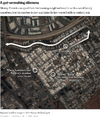
Her mother and sister died in someone’s car near the intersection of Kuhua and Aki streets in Kuhua Camp, about three blocks from their home, Maui police told them. But authorities provided few additional details, declining to say whose car they were in. The only clue: The driver died wearing a gold necklace.
Pico, the police spokesperson, said after the fire, the agency provided “the best information available to us at the time” to victims’ relatives.
Near the narrow intersection where Tomboc and Lutriana were found, a downed tree and other debris appears to have created a deadly bottleneck where satellite imagery taken in the days after the fire shows the charred shells of burned-out cars.
Diego Rivera, 26, who lived on Kopili Street around the corner from Claire’s relatives, said he jumped into a pickup with strangers at Aki Street, but got stuck near the same spot in a line of vehicles, behind a fallen tree and downed power line.
For 13 minutes, the driver and another passenger in the truck were on the phone with a 911 dispatcher, “just like pleading and begging them to bring over a car,” Rivera said, “you know, to just run through the f—ing tree to help this whole fleet of people escape.”

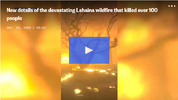
“I’m sorry, I’m sorry,” the dispatcher tells them. “I’m letting them know that the area is all blocked out.”
With fire swirling all around them, panicked motorists in several of the vehicles finally rammed their way through and over the tree, driving past a line of burning homes and cars — and past a lifeless body lying next to the street — while escaping. But not all cars could get past the tree, Rivera said.
“A bunch of people died for sure, right there, in my neighborhood,” Rivera said.
Pico, the police spokesperson, confirmed that at 4:41 p.m. a police dispatcher broadcast to officers, “There’s a big tree down, Kuhua and Aki, if you’re headed that way. It’s blocked.”
But officers were not in the area and busy trying to evacuate other parts of town, Pico said, “and it was not addressed.”
In November, Claire and her family laid Tomboc and Lutriana to rest in a small ceremony attended only by local relatives. Life was too unstable at the time to invite loved ones from the Philippines, they said, and West Maui hotels were still packed with survivors.
Manny said he doesn’t regret his split-second decision the day of the fire to evacuate his mother and children first.
“I prayed that my mind would focus and I would do the right thing,” he said. “I think I did that.”
Claire misses her mother’s cooking and watching Korean shows with the subtitles turned on, she said, laughing at the memory of their weekly TV binges. Her kids miss seeing their grandmother.
For the last several months, Manny and Claire and their family have been living in a Ka’anapali hotel.
Manny said he worries their homeowners insurance will only cover the cost of the existing house, without compensation for the unfinished additions.
County and state officials have said it will likely be years before rebuilding can begin. Even then, some of Manny’s neighbors may not return.
“If they rebuild this neighborhood exactly the way it was, I don’t want to live there,” said Kim, the longtime resident. “It’s just going to happen again. Maybe not this drastic, but people are going to die from getting trapped.”
Manny said he and Claire have trouble sleeping. They’re worried about their future. They’re unsure who to blame. “There is nothing to do but accept fate,” Manny said.
The idea of returning and rebuilding their home seems like a distant dream, he said. All that’s left: four charred front steps leading to ashy ruins.


